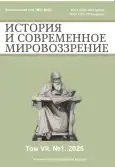Формирование организационных структур и кадровое обеспечение археологических исследований на территории Ханты-Мансийского автономного округа в начале 1990-х гг.
- Авторы: Фролов И.В.1
-
Учреждения:
- Сургутский государственный университет
- Выпуск: Том 7, № 1 (2025)
- Страницы: 185-192
- Раздел: АРХЕОЛОГИЯ
- URL: https://journal-vniispk.ru/2658-4654/article/view/292465
- EDN: https://elibrary.ru/IQEFNQ
- ID: 292465
Цитировать
Аннотация
В своей культурной политике органы государственной власти ориентируются на общественный запрос. Одновременно общественный запрос всегда формулируется профессиональным сообществом. В отсутствии ясно сформулированного общественного запроса и реализация политики часто носит формальный характер, нередко вообще не находит своего воплощения. Это хорошо прослеживается на примере организации охраны и изучения объектов археологии на региональном уровне. Хронологические рамки исследования охватывают период с 1990 г. — принятия Декларации о государственном суверенитете РСФСР — до принятия регионального закона о сохранении и использовании историко-культурного наследия Ханты-Мансийского автономного округа в 1997 г. До принятия Конституции РФ в 1993 г. Ханты-Мансийский автономный округ не обладал всеми правами субъекта и не имел собственных региональных органов власти, ответственных за охрану культурного наследия. Особенностью историко-культурного наследия Югры является значительное преобладание археологических и этнокультурных объектов над памятниками архитектуры и монументального искусства, археологические памятники составляют 94% от общего их числа. Цель исследования: по архивным материалам проследить влияние гуманитарного сообщества профессиональных археологов, выразителей общественного запроса на сохранение культурного наследия, на взаимоотношения общества с органами местного самоуправления и на возникновение региональных органов государственной власти Ханты-Мансийского автономного округа в период 1990–1997 гг.
Полный текст
Открыть статью на сайте журналаОб авторах
Иван Викторович Фролов
Сургутский государственный университет
Автор, ответственный за переписку.
Email: arqueolog@mail.ru
ORCID iD: 0000-0002-4220-0743
SPIN-код: 9809-7327
аспирант
Россия, СургутСписок литературы
- Ведмидь Г.П., Бочкарев Д.В. Достопримечательное место «Барсова Гора» — уникальный природно-археологический памятник Сургутского Приобья // Баландинские чтения: Сб. ст. VIII науч. чтений памяти С.Н. Баландина. Новосибирск, 2014. С. 30–44.
- Визгалов Г.П., Фролов И.В. Организация археологических исследований в Нефтеюганском районе ХМАО-Югры в условиях трансформации государственно-правового регулирования в 1992–2002 гг. // Вестник СурГПУ. № 5 (80), 2022. С. 187–195.
- Зайцева Е.А. История археологических исследований Сургутского Приобья (конец XIX — 90-е годы XX вв.) // Вестник угроведения. 2012. Т. № 1 (18). С. 116–131.
- Сорокина И.А. Императорская археологическая комиссия и становление полевых исследований в отечественной археологии // Проблемы истории, филологии, культуры. №4. М. — Магнитогорск,2009 С.13-21.
- Сорокина И.А. Регламентация полевых исследований в России и представления о ней государства, ученых и общественности во второй половине XIX и начале XX веков // Российский археологический ежегодник — № 1 — 2011. С. 452–471.
- Сорокина И.А. Полевая археология в Самарской региональном центре в 1950-2009 гг. (по архивным материалам ИА РАН) // Известия Самарского научного центра Российской академии наук. Т.15. №1, 2013. С. 235–241.
- Союрова А.В. Охрана памятников истории и культуры на Севере Западной Сибири в 1917-1991 гг. (по материалам Ханты-Мансийского автономного округа-Югры: Автореф. дисс. к.и.н.: 07.00.02 / А.В. Союрова. — Екатеринбург, 2015. — 30 с.
- Чемякин Ю.П., Зыков А. П. Барсова Гора: археологическая карта. Сургут, Омск: ОАО «Омский дом печати», 2004. 208 с.
Дополнительные файлы








